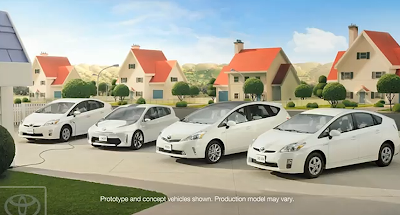The dust has settled on the Tokyo Motor Show, traditionally the outlet for the industry’s most avant-garde predictions.
2007’s debuts didn’t disappoint, although the host country’s penchant for bizarre city cars is starting to look rather less eccentric as public perception shifts in their favor.
As well as some cracking urban concepts from Honda, Toyota and Nissan, here’s
Wallpaper's round-up of the show’s scattering of the bold and the brave.

Above: Lexus LF-Xh concept
As a luxury brand, Lexus doesn’t dabble in the small scale. It is, however, fully committed to lowering emissions, so while the size of the LF-Xh concept was an eye-opener in these eco-conscious times, the news that the urban SUV packed the latest version of the company’s tried and tested hybrid drive was far more welcome.
The concept is sleek but not improbably so, and many elements of the design will make their way into next year’s new RX model. The wrap-around, folding interior structure seems strongly influenced by contemporary architecture.

Above: Audi metroproject quattro concept
Mindful that the media’s eyes would be drawn to the more unusual fare on show, few major Western manufacturers brought all-new models to the show. Audi were the exception, and while the metroproject is ostensibly a design study, it’s actually a near production-ready version of 2009’s A1 city car.
The concept uses a mild hybrid drive to keep emissions down, while the swooping roof line gives the car an easily identifiable silhouette. The metro project also includes Audi’s new in-car remote control, a hand held device designed to control the car’s functions (try switching on the heater before you’ve even stepped out of the front door on a winter’s morning). Expect the idea to spread across the company’s entire range before long.

Above: Honda CR-Z Concept
The CR-Z offered a rather more believable view of the future than most concepts on show. Standing for ‘Compact Renaissance - Zero’, the car’s anteater-like snout and extreme wedge shape all hint at a low drag shape.
Intended as a sporting take on the ubiquitous hatchback, expect elements of the CR-Z to surface in the 2009 model year, with hybrid power on board right from the start. Sadly, the neon-striped spaceship feel of the interior might not make it to the showroom.

Above: Mitsubishi i MiEV Sport
A sporting variant on the Mitsubishi i, the i MiEV Sport is a low-slung fastback city car, with a scarab-shaped bodyshell and an all-electric, all-wheel drive power train.
Foam green bodywork offsets the high-tech goings on below, including solar cells in the roof and a miniature wind turbine concealed behind the grill. The two plus two is pitched at the sporting environmentalist - an oxymoronic consumer profile the auto industry is keen to cultivate.

Above:Suzuki Pixy and Sharing Coach
In the future, Suzuki’s futurists expect we’ll want a car that fragments into smaller vehicles, taking each occupant a stage further on their individual journeys. This ‘sustainable mobility’ concept is embodied in the SSC, the Suzuki Sharing Coach.
Essentially a box on wheels, each SSC can contain two PIXYs, a curious personal transportation module with an upright stance and the ability to enter buildings. It’s a solution to a problem that doesn’t yet exist, but Suzuki are banking on the pod people taking over the pavements of tomorrow as a response to smog-shrouded roadways.


Above: Nissan Intima
Big saloons still sell by the boatload in Asia. Nissan’s Intima looks relatively conventional but is saved from mass-market dreariness by the clamshell doors that open up the cavernous interior and the teardrop-shaped windscreen that extends high over the passenger seats.
The thought of seats that swivel round to deposit you on the pavement might appeal to Japan’s fast-ageing population, although the firm is pitching this as a, and we quote, ‘New-generation Saloon for People with a Sophisticated, Discerning Eye for Beauty’.

Above: Nissan RD/BX
Nissan’s ‘Round Box’ Concept epitomises the current trend towards the toy-like, a bulked-up four-seater that features a bluff frontage and open-air top. In corporate speak that translates into a ‘Youth-Oriented Compact Convertible’, hence the emphasis on being a mobile social environment. The driver gets the usual quota of lights and dials, while the satnav system can be accessed by anyone (sure to cause a few arguments).

Above:Daihatsu Mud Master-C
With its Tonka Toy moniker and four-square stance, the Mud Master-C is an almost comically cute reinterpretation of the classic go-anywhere utility vehicle. Reminiscent of any number of ultra-tough models from the classic Unimog onwards, the Mud Master-C was actually developed in collaboration with one of Japan’s leading mountain bikers, Raita Suzuki, as a ‘support vehicle.’ Deliveries never need be delayed again.


Above: Toyota RiN / Toyota Hi-CT
While Toyota’s 1/X hybrid concept was relatively conventional, the company let loose its creative juices with the RiN and Hi-CT. The latter was a joystick-steered, mini utility vehicle, with an upright cab and space on the back platform to haul anything you please. Plug-in hybrid drive comes as standard.
The RiN was even more avant-garde, a push-me-pull-you style urban vehicle inspired by tea houses and the dream of zero emissions. The white bodywork was decorated with organic forms, and the green carpet was a not-so-subtle way of turning the driving experience into a soothing walk in the park.
Source: Wallpaper Magazine






















































